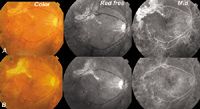Article
Treating proliferative diabetic retinopathy with off-label drug shows promise
Author(s):
Las Vegas-Intravitreal injection of bevacizumab (Avastin, Genentech Inc.) to treat proliferative diabetic retinopathy, an off-label use of the drug, induces marked regression of neovascularization and may be a valuable adjunct to vitrectomy for proliferative diabetic retinopathy because there is markedly reduced bleeding at vitrectomy, according to Robert Avery, MD, who spoke at the American Academy of Ophthalmology annual meeting.

He recounted the case of the first patient he treated with bevacizumab for proliferative diabetic retinopathy more than 1 year previous to this presentation. The patient had a vitreous hemorrhage in one eye, which was treated with laser, and neovascularization on the disc in the fellow eye, which was treated with an intravitreal injection of bevacizumab.
"One week after treatment, fluorescein angiography showed that there was fairly dramatic resolution of the leakage from the vessels, and the same occurred on the iris," he said. Dr. Avery is co-director of the California Retina Research Foundation, and in private practice in Santa Barbara, CA.

He also pointed out that when the images of the optic nerve head were enlarged after treatment, faint vessels were still visible; the largest vessels did not completely resolve. This is similar to the result after laser treatment, despite resolution of the leakage.
"The results from the study published in Ophthalmology showed complete resolution of the leakage of the neovascularization of the nerve head and on the iris in only about 75% to 85% of the cases. There was some improvement in the leakage at 1 week in all 44 eyes for which we had angiograms," Dr. Avery reported.
He also pointed out that lower doses of bevacizumab could be used. He showed images from a patient who received one- tenth of a dose (125 µg) and had complete resolution of leakage following injection of bevacizumab. Other patients received 62 µg and 12.5 µg and the leakage stopped, although he noted that with the lowest dose the peripheral neovascularization persisted and recurred at 6 weeks after injection, which is sooner than with higher doses at 3 months. One day after a second injection, the recurrence abated and resolved. The lowest dose tested was 6 µg (1/200th the typical dose); this resulted in partial resolution of the neovascularization closest to the nerve head but fairly incomplete regression, he reported.
Newsletter
Don’t miss out—get Ophthalmology Times updates on the latest clinical advancements and expert interviews, straight to your inbox.




